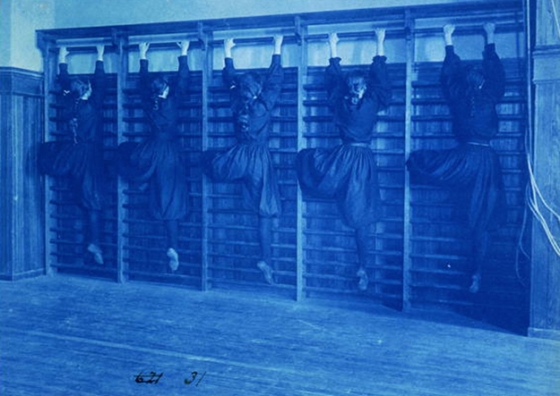Frances Benjamin Johnston, born in West Virginia in 1864, is said to have received one of her first cameras from Kodak founder George Eastman, a friend of her well-connected family. I don’t know if that is a Kodak in the shot above, but it looks likely. It seems to have been taken in the 1890s – thus not long after Eastman had debuted the portable camera in 1888 – while the cyanotype below of her with a large-format camera on a balcony of the State, War and Navy Building was taken in 1888. (This also almost certainly gives the lie to the oft-repeated notion that her “first” camera was from Eastman; she is said to have written him about his new, lighter-weight camera in 1889, after which he sent her one.)
Johnston had grown up in Washington, D.C., and partly through her mother’s associations there (she was the Washington correspondent for the Baltimore Sun and “knew all of the important people” in addition to being related to President Grover Cleveland’s wife), many of the city’s doors were opened for her, and as early as while she was still in her late 20s. As her biography on answers.com says, “from the 1880s into the 1910s, she would take pictures during the administrations of Presidents Cleveland, Harrison, McKinley, Roosevelt, and Taft. This resulted in an outstanding and historically invaluable pictorial document that depicted the members of the various first families, as well as White House staff members and visitors.” Johnston even took the final image of the living President McKinley minutes before he was assassinated at the Buffalo Exhibition in 1901.
She also opened a portrait studio in the city in 1894, photographing everyone from Mark Twain to Booker T. Washington to Susan B. Anthony. She was the only female commercial photographer in the city, and in 1897 she published an article in The Ladies Home Journal, “What A Woman Can Do With A Camera,” in which she shared some of the expertise she had gained. It’s a charming piece, and includes this observation: “It is a profession that should appeal particularly to women, and in it there are great opportunities for a good-paying business – but only under very well-defined conditions…: The woman who makes photography profitable must have, as to personal qualities, good common sense, unlimited patience to carry her through endless failures, equally unlimited tact, good taste, a quick eye, a talent for detail, and a genius for hard work. In addition, she needs training, experience, some capital, and a field to exploit.”
At least Johnston acknowledges how intimidating that sounds: “This may seem, at first glance, an appalling list, but it is incomplete rather than exaggerated; although to an energetic, ambitious woman, with even ordinary opportunities, success is always possible.” I’m sure that is true, although one could probably surmise that in her case it couldn’t have hurt to have the connections provided by her family, not to mention the art education in Paris that preceded her photography career. She received her initial photography training, for example, from Thomas Smillie, director of photography at the Smithsonian, and then in the 1890s, according to this article from Fredericksburg.com (Johnston photographed and exhibited in the area in the 1920s), she “toured Europe, using her connection to Smillie to visit various prominent photographers and gather items for the museum’s collections.”
Johnston also “served for a time as a Washington liaison for newly formed Eastman Kodak, forwarding film and serving as a customer service representative when lenses or cameras needed repairs. In this role, she gained firsthand working knowledge of her craft and the fine details of her equipment.”
However she got her start, Johnston quickly became one of the finest photographers of her generation, branching out from her beginnings as a portrait photographer to become, in the first decade of the 20th century, what is generally regarded as America’s first female photojournalist. Some time after that she developed an interest in the South, and particularly its vanishing architecture, and the Fredericksburg.com article notes that in the ’30s she often “covered more than 12,000 miles annually in her quest to capture the rapidly vanishing icons of America’s past….Johnston was particular and professional in her approach to a subject. Well into her 80s, she was known to lie on her back on a hard floor in order to capture just the right angle on a ceiling adornment. One of her photos can tell more about a site than a dozen from another source.”
Johnston, who never married (she was by some accounts a lesbian, and produced several intriguing self portraits, sometimes dressed as a man, complete with fake mustache) led an interesting, independent – some have called it Bohemian – life, finally settling in New Orleans, where she died at the age of 88 in 1952. Her collection of more than 20,000 photographs and almost 4,000 negatives resides in the Library of Congress.




